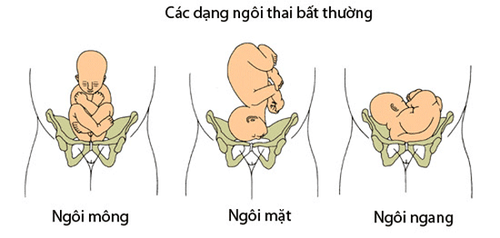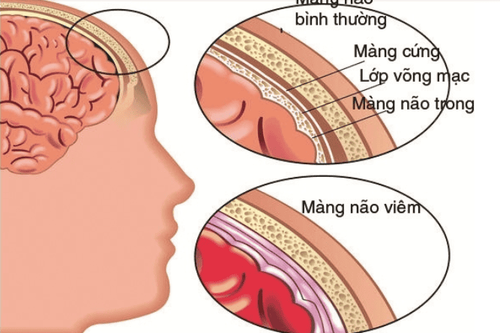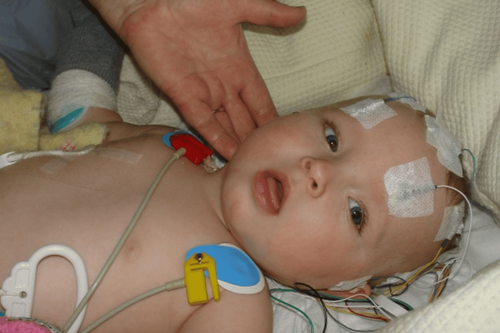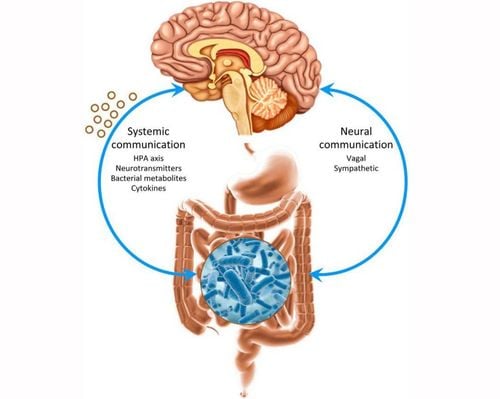This is an automatically translated article.
The article is professionally consulted by Master, Doctor Nguyen Thi An - Pediatrician - Neonatologist - Department of Pediatrics - Neonatology - Vinmec Ha Long International General Hospital. The doctor is a person who is very passionate about health care for children and has experience in successfully treating many cases of early cerebral - meningeal haemorrhage in young children.Hemorrhage in a newborn is a dangerous condition, the most common is bleeding under the skin, bleeding in the brain, meninges... Severe brain hemorrhage leads to compression or damage to brain tissue leading to The mortality rate is high, the rate of sequelae is 40-50%.
1. What is an infant brain hemorrhage?
Neonatal brain hemorrhage is one of the most common birth injuries, ranging from mild to extremely serious.The cause of neonatal cerebral hemorrhage can be asphyxia at birth, due to lack of oxygen during labor or immediately after birth, or due to birth trauma, trauma due to excessive mechanical force. on the child's head, possibly due to a clotting disorder. In many cases, this can also be a complication of medical malpractice during delivery. For example, doctors may misuse tools such as forceps and suction cups...
Whatever the cause, it is imperative to diagnose a neonatal brain hemorrhage as soon as possible to children receive timely treatment and limit severe sequelae in the future.
2. What are the types of cerebral hemorrhage in infants?
There are different types of neonatal brain hemorrhage, including intracerebral (inside the brain) and extracranial (outside the brain).2.1. Intracerebral hemorrhage
2.1.1 Hemorrhagic stroke
A hemorrhagic stroke occurs when a blood vessel bursts, causing extensive bleeding in the brain parenchyma. This can cause a group of brain cells to become starved of oxygen and nutrients. A hemorrhagic stroke can also lead to a build-up of pressure, causing irritation and swelling of the brain parenchyma, eventually causing brain damage in the newborn.2.2.2 Subarachnoid hemorrhage
Subarachnoid hemorrhage is characterized by bleeding from blood vessels in the subarachnoid space, which is the innermost area of the two membranes that cover the brain parenchyma.2.2.3 Intraventricular hemorrhage
Intraventricular hemorrhage occurs when there is bleeding into the ventricular system in the brain parenchyma, which is responsible for the production and drainage of cerebrospinal fluid. This is a very serious type of intracranial bleeding and is commonly seen in premature babies and babies with low birth weight. The mechanism is that the blood vessels in the brain of premature babies are not fully developed and are therefore weaker than those of full-term infants. Not only that, hypoxia and birth trauma can also contribute to intraventricular hemorrhage.
Xuất huyết não thất thường xuyên xảy ra đối với trẻ sinh non
2.2.4 Subdural hemorrhage and subdural hematoma
A subdural hemorrhage occurs when one or more blood vessels in the subdural space burst. The cause of ruptured blood vessels at this site is often trauma, which can include trauma during labor.2.2. Extracranial hemorrhage
2.2.1 Head hematoma
A bump on the scalp, which may be accompanied by bleeding, extends along the rim of the mouthpiece of the aspirator placed on the child's head.2.2.2 Head hemangioma
Head hemangioma is a type of brain hemorrhage characterized by bleeding occurring between the skull and the scalp. This may be a worsening of the head hematoma when aspiration is used or the baby's head remains too long in the mother's lower genital tract during prolonged labor. Head hemangiomas may disappear on their own, but should be carefully monitored by the neonatologist. Sometimes babies need treatment for related complications such as anemia and jaundice.2.2.3 Epidural hematoma
A condition in which blood accumulates in the area between the dura mater and the skull, where there is only loose connective tissue.3. What are the risk factors for cerebral hemorrhage in infants?
Common risk factors and causes of intracerebral hemorrhage in infants include:Macrocephaly: This is a pregnancy condition in which the fetus is larger than average for gestational age. can make vaginal labor dangerous. Pelvic head asymmetry: Pelvic head asymmetry is also one of the same problems as a large fetus. There is also a size mismatch between the fetal head and the maternal pelvis when the head is abnormally large and/or the pelvis is abnormally small. The fetal position, the presentation of the abnormal fetus, such as the breech position, the face position, or the forehead position. Trauma from prolonged labor. Coagulation disorders, such as vitamin K deficiency or congenital hemophilia. Ischemic Encephalopathy: Ischemic encephalopathy is a dangerous neonatal brain injury caused by decreased oxygen and blood flow to the infant at or near the time of birth. The lack of blood flow leads to mass cell death and causes blood vessel walls to break down, resulting in bleeding out of the vessel lumen. Medical interventions during labor such as forceps or suction machine Incorrect stage of delivery: Improper pushing technique. At the same time, the birth attendant twists or pulls excessively on the infant's head...

Xuất huyết não ở trẻ sơ sinh có thể do sự bất thường của ngôi thai
4. Are signs and symptoms of cerebral hemorrhage in a newborn dangerous?
Symptoms of an intracerebral hemorrhage in a newborn will vary based on the type and severity of the condition. In particular, the following signs will be relatively common.Fever Poor suckling or aborting Crying Swollen fontanel Decreased consciousness, lethargy, somnolence Seizures Persistent pauses in breathing Shallow or rapid breathing
5. How is a brain hemorrhage diagnosed in a newborn?
When there are signs of intracerebral hemorrhage or suspicion of this possibility, especially in high-risk neonates, the diagnosis of ICH will require the use of imaging tools to confirm presence of free blood in the skull. Popular means include:5.1 Transcranial Doppler ultrasound
By using sound waves to measure flow, blood flow rate, and echogenicity of structures, transcranial Doppler ultrasound is a noninvasive test that provides an image of the overall blood flow throughout the body. brain parenchyma. This medium is quite popular among children thanks to the fontanelles of the skull - which act as natural "windows".5.2 Magnetic resonance imaging or cranial tomography (MRI or CT Scan)
These imaging modalities are performed with relative ease, showing the intracranial structures in detail. However, there is a potential risk of X-ray exposure in young children.5.3 Contrast angiography
This is an invasive procedure. In it, the doctor will thread a thin, very small tube that is inserted into the blood vessels that carry blood directly to the brain and then inject contrast dye. The image of the blood vessels observed will be clearly shown thanks to the contrast of the drug in the blood vessel. If the drug escapes from the lumen, it is clear evidence for the diagnosis of cerebral hemorrhage. However, this means is not the first choice because of the risk of injury during the procedure, as well as the risk of X-ray exposure and complications when using contrast.6. What are the treatments for intracranial hemorrhage in infants?
Treatment of neonatal intracerebral hemorrhage depends largely on the size of the bleeding mass, the cause and risk factors, and the child's current physical characteristics.Treatment options may include medical treatment and surgical treatment depending on the cause of bleeding; surgical treatment: subcutaneous approach to repair abnormal blood vessels, including catheterization, bioglue, balloon insertion or occlusion, or craniotomy if the blood mass is large, there is a risk of compression squeeze. From there, the outcomes as well as long-term sequelae in life after a neonatal hemorrhagic event will depend a lot on the severity of the hemorrhagic mass and the decision on treatment and follow-up today. .
In short, the baggage a newborn needs to go through to cry out at birth always contains risks of injury, which can range from mild to severe, depending on the type of injury and what part of the baby's body is affected. affect. In particular, neonatal cerebral hemorrhage is a fairly common birth injury for many reasons. However, regardless of the cause, children always need to be treated immediately to ensure the best outcome and limit sequelae.
Please dial HOTLINE for more information or register for an appointment HERE. Download MyVinmec app to make appointments faster and to manage your bookings easily.













